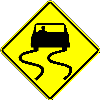Global Navigation

Main Navigation
Sub-Navigation

Content
On the other hand, softer compounds wear faster because, just like wood sliding across sandpaper, the friction created between our tires and the road scuffs or scrubs some of the rubber away. Some tires are made with a combination of compounds. For example, the center of the tire may be harder to provide longer wear in straight riding with the sides softer to allow for better cornering. Most tire manufacturers produce a wide range of tires (models) with a variety of compounds to match the needs of different riding styles.
It is important we do our homework, if only at our dealership, to ensure we have the right tires on our iron horse. While this research is important, it is even more critical to ensure we are taking care of those tires. After all, they are the only thing between the road and us. (See Tire Maintenance Tips)
So now we've done what we can to maximize the traction our tires can give us, what next? We've still got to share that traction with the traction users while holding some back for the unforeseen. That comes down to understanding how each of the traction users works and how our riding impacts the amount of traction required. Responsible riders constantly think about and manage their traction to ensure they have a safety margin just in case. In future articles, we'll explore how each of the ABC traction forces uses our traction as we ride.
Sidebar
Footer
Copyright 1996-2015 Chuck Miles All Rights Reserved
All information on this site, including all articles, are copyrighted materials belonging to Chuck Miles.
Design: Made in Austria | Author: G. Wolfgang





